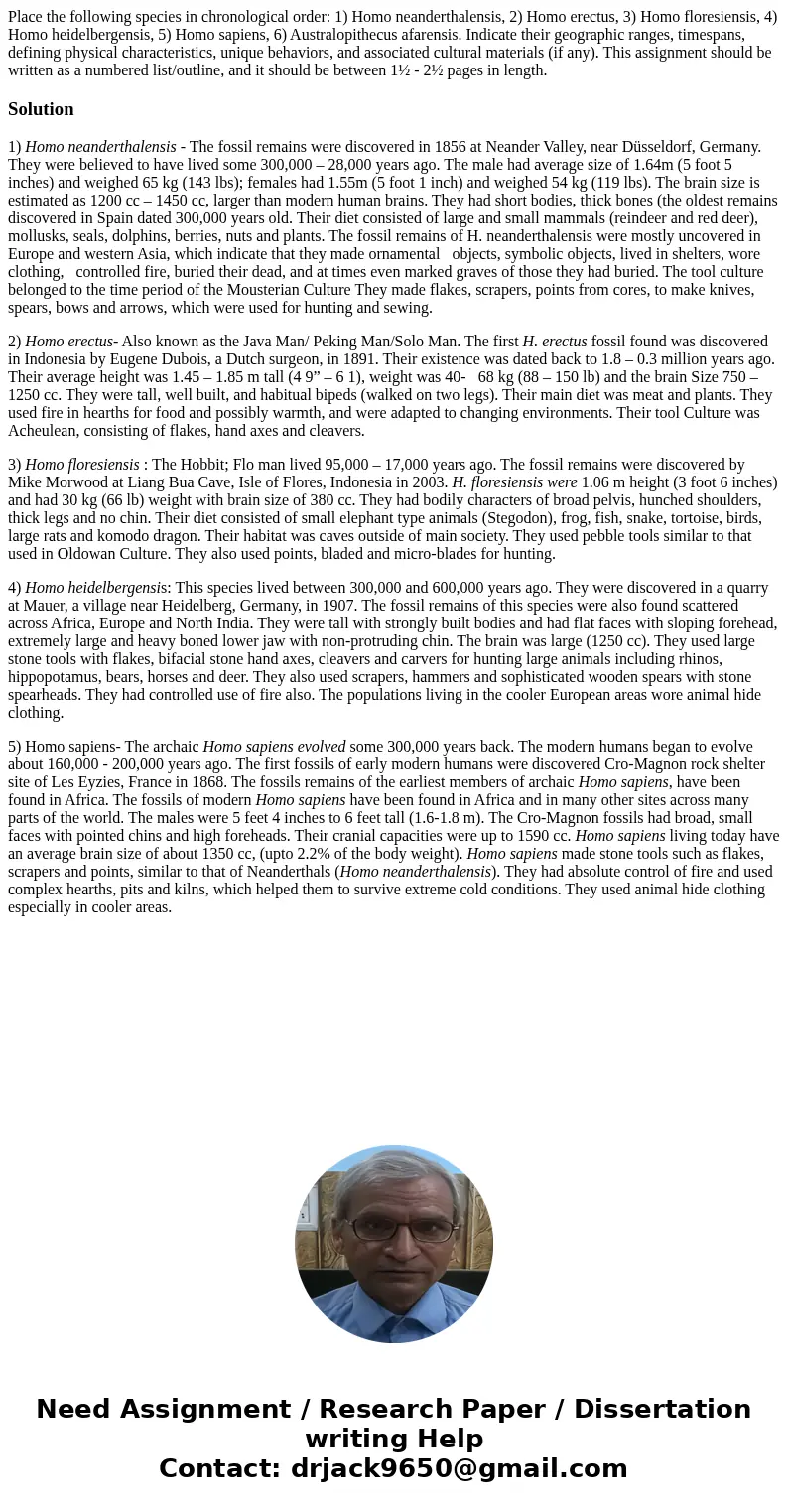Place the following species in chronological order 1 Homo ne
Place the following species in chronological order: 1) Homo neanderthalensis, 2) Homo erectus, 3) Homo floresiensis, 4) Homo heidelbergensis, 5) Homo sapiens, 6) Australopithecus afarensis. Indicate their geographic ranges, timespans, defining physical characteristics, unique behaviors, and associated cultural materials (if any). This assignment should be written as a numbered list/outline, and it should be between 1½ - 2½ pages in length.
Solution
1) Homo neanderthalensis - The fossil remains were discovered in 1856 at Neander Valley, near Düsseldorf, Germany. They were believed to have lived some 300,000 – 28,000 years ago. The male had average size of 1.64m (5 foot 5 inches) and weighed 65 kg (143 lbs); females had 1.55m (5 foot 1 inch) and weighed 54 kg (119 lbs). The brain size is estimated as 1200 cc – 1450 cc, larger than modern human brains. They had short bodies, thick bones (the oldest remains discovered in Spain dated 300,000 years old. Their diet consisted of large and small mammals (reindeer and red deer), mollusks, seals, dolphins, berries, nuts and plants. The fossil remains of H. neanderthalensis were mostly uncovered in Europe and western Asia, which indicate that they made ornamental objects, symbolic objects, lived in shelters, wore clothing, controlled fire, buried their dead, and at times even marked graves of those they had buried. The tool culture belonged to the time period of the Mousterian Culture They made flakes, scrapers, points from cores, to make knives, spears, bows and arrows, which were used for hunting and sewing.
2) Homo erectus- Also known as the Java Man/ Peking Man/Solo Man. The first H. erectus fossil found was discovered in Indonesia by Eugene Dubois, a Dutch surgeon, in 1891. Their existence was dated back to 1.8 – 0.3 million years ago. Their average height was 1.45 – 1.85 m tall (4 9” – 6 1), weight was 40- 68 kg (88 – 150 lb) and the brain Size 750 – 1250 cc. They were tall, well built, and habitual bipeds (walked on two legs). Their main diet was meat and plants. They used fire in hearths for food and possibly warmth, and were adapted to changing environments. Their tool Culture was Acheulean, consisting of flakes, hand axes and cleavers.
3) Homo floresiensis : The Hobbit; Flo man lived 95,000 – 17,000 years ago. The fossil remains were discovered by Mike Morwood at Liang Bua Cave, Isle of Flores, Indonesia in 2003. H. floresiensis were 1.06 m height (3 foot 6 inches) and had 30 kg (66 lb) weight with brain size of 380 cc. They had bodily characters of broad pelvis, hunched shoulders, thick legs and no chin. Their diet consisted of small elephant type animals (Stegodon), frog, fish, snake, tortoise, birds, large rats and komodo dragon. Their habitat was caves outside of main society. They used pebble tools similar to that used in Oldowan Culture. They also used points, bladed and micro-blades for hunting.
4) Homo heidelbergensis: This species lived between 300,000 and 600,000 years ago. They were discovered in a quarry at Mauer, a village near Heidelberg, Germany, in 1907. The fossil remains of this species were also found scattered across Africa, Europe and North India. They were tall with strongly built bodies and had flat faces with sloping forehead, extremely large and heavy boned lower jaw with non-protruding chin. The brain was large (1250 cc). They used large stone tools with flakes, bifacial stone hand axes, cleavers and carvers for hunting large animals including rhinos, hippopotamus, bears, horses and deer. They also used scrapers, hammers and sophisticated wooden spears with stone spearheads. They had controlled use of fire also. The populations living in the cooler European areas wore animal hide clothing.
5) Homo sapiens- The archaic Homo sapiens evolved some 300,000 years back. The modern humans began to evolve about 160,000 - 200,000 years ago. The first fossils of early modern humans were discovered Cro-Magnon rock shelter site of Les Eyzies, France in 1868. The fossils remains of the earliest members of archaic Homo sapiens, have been found in Africa. The fossils of modern Homo sapiens have been found in Africa and in many other sites across many parts of the world. The males were 5 feet 4 inches to 6 feet tall (1.6-1.8 m). The Cro-Magnon fossils had broad, small faces with pointed chins and high foreheads. Their cranial capacities were up to 1590 cc. Homo sapiens living today have an average brain size of about 1350 cc, (upto 2.2% of the body weight). Homo sapiens made stone tools such as flakes, scrapers and points, similar to that of Neanderthals (Homo neanderthalensis). They had absolute control of fire and used complex hearths, pits and kilns, which helped them to survive extreme cold conditions. They used animal hide clothing especially in cooler areas.

 Homework Sourse
Homework Sourse